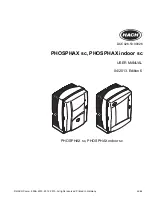
Model 520 HT UCA
D01157216
Revision A, October 2015
24
6
Front Panel Controls
The controls can be divided into three categories: hydraulic controls that control the
pressure inside the reservoir, pneumatic controls that control the air pressure to the
pump, and the switches that control the electrical components of the instrument.
6.1
Hydraulic Pressure Controls
This section consists of the following controls: the PRESSURE RELEASE valve,
the PRESSURE REGULATOR, the REGULATOR BYPASS valve, and the
WATER SUPPLY switch. Components that make up this section are used to
control the flow of water used to pressurize the cylinder.
The PRESSURE RELEASE valve is used to release pressure from the pressurized
cylinder. This valve must be closed during testing except when it is necessary to
manually release pressure. This valve must also be closed when removing the
pressure vessel with cooling water circulating or cooling water may back up and
leak out the pressure port in the top of the instrument.
The PRESSURE REGULATOR may be used to set the upper limit on the system
pressure up to 10,000 psig/680 bar. When the hydraulic force on the regulator
exceeds the spring force of the regulator, the regulator valve will open and release
pressure until the hydraulic and spring forces balance again. The regulator will
then close preventing any additional pressure release until the hydraulic force again
exceeds the spring force. Turn the PRESSURE REGULATOR knob clockwise to
increase pressure and counterclockwise to reduce pressure.
The pressure regulator is only usable at pressures up to 10,000 psig/680 bar. To
operate the UCA at pressures above 10,000 psig/680 bar, the REGULATOR
BYPASS must be turned clockwise to the closed position. For automatic operation
at pressures below 10,000 psig/680 bar, the PRESSURE REGULATOR SHUTOFF
valve must be turned counterclockwise to the fully open position.
The WATER SUPPLY valve is used to control the flow of water to the pump and
test cell. This valve must be closed any time the test cell is not installed. This
valve must be open to fill the pressure vessel with water or to operate the pump.
Opening this valve when the test cell is not connected will cause a serious water
leak.
6.2
Pneumatic Controls
The pneumatic section consists of the AIR TO PUMP gauge and the AIR TO
PUMP regulator. The components in this section are used to power the air driven
hydraulic pump that applies pressure to the sample.
The AIR TO PUMP gauge indicates how much air pressure is being supplied to the
instrument. If there is no pressure indicated on this gauge, the pump will not












































